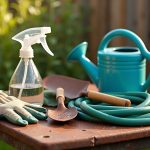Starting your first garden is exciting—but figuring out what tools you actually need? That part can be confusing. The gardening aisle is packed with gear, and it’s easy to feel overwhelmed.
Here’s the truth: you don’t need a garage full of gadgets to grow something great. Just a small set of reliable tools can make all the difference.
If you’re wondering things like:
- What should I plant first?
- How do I deal with weeds and bugs?
- What tools do I really need to get started?
You’re not alone. We’ve been there, too.
This guide covers 10 beginner-friendly tools that’ll help you dig, plant, water, and care for your garden with confidence.
Here are the 10 Essential Gardening Tools:
- Gardening Gloves
Start here. A solid pair of gloves protects your hands from thorns, rough soil, blisters, and bugs. Choose gloves made from breathable but tough materials—like reinforced fabric or soft leather—and make sure they fit well. Comfortable gloves can mean the difference between a fun afternoon and sore hands. - Hand Trowel (or Hori Hori Knife)
Think of this as your go-to mini shovel. A hand trowel is perfect for digging holes, transplanting, or moving soil around pots. Some gardeners also love the hori hori knife—it’s sharp, multi-purpose, and even has measurement marks for planting depth. - Pruning Shears
Hand pruners make quick work of trimming stems, deadheading flowers, or harvesting herbs. Go for a pair that cuts clean and feels good in your hand. Keep the blades sharp, and they’ll last for years. - Hand Fork or Cultivator
This claw-like tool is great for loosening soil, mixing in compost, and pulling out weeds. Look for strong metal tines that won’t bend easily. It’s a favorite for prepping small beds or raised containers. - Watering Can or Garden Hose
All gardens need water—but how you deliver it depends on your space. A watering can is ideal for smaller gardens or delicate plants. If you’ve got more ground to cover, a hose with a spray nozzle offers flexibility and reach. - Garden Shovel or Spade
If you’re digging larger holes or moving compost and soil, a full-size shovel is your best friend. A round-point shovel works well for most beginner tasks. Choose one with a comfy grip and a solid steel head. - Garden Rake
A metal bow rake is super helpful for smoothing soil, spreading mulch, and clearing leaves or sticks. It’s a true multitasker when you’re prepping beds or cleaning up. - Garden Hoe
Planning to grow veggies or work in beds? A hoe helps you scrape weeds, shape rows, and loosen surface soil fast. A basic flat garden hoe is easy to use and perfect for keeping your plot tidy. - Kneeling Pad or Garden Kneeler
Working close to the ground takes a toll on your knees. A thick foam pad or garden kneeler gives you comfort and support while you plant or weed. It’s one of those tools you won’t realize you need—until you use it. - Wheelbarrow or Garden Cart
If you’re hauling soil, mulch, plants, or tools around, a wheelbarrow will save your back. For beginners, a medium-sized, lightweight model is easier to handle but still big enough for most jobs.
What Our Team Uses (Real Picks & Why)
We’ve tested plenty of tools over the years—here are some we love:
- Bionic ReliefGrip Gardening Gloves with reinforced palms for working with roses and tomatoes. They’ve saved us from thorns.
- Fiskars Ergo Trowel with a wide stainless steel blade. It’s perfect for scooping soil into containers—never bends.
- Felco F-2 Bypass Pruners. They’re smooth, sharp, and they’ve lasted us five growing seasons.
- Gorilla Carts GOR400 two-wheeled garden cart. It’s easier to control and great for moving heavy pots without tipping.
These aren’t sponsored picks—just what we genuinely use in our own spaces.
Budget Tips: How to Start Without Spending Too Much
Gardening doesn’t have to break the bank. Here are a few tips to keep costs low:
- Buy only what you need. Start with the basics, and skip specialty tools until you know you need them.
- Borrow or share. Ask neighbors or friends if they have tools you can borrow—most people are happy to lend.
- Shop secondhand. Check local thrift shops, garage sales, or online marketplaces for gently used tools.
- Take care of what you buy. A quick clean after each use helps tools last longer and saves money in the long run.
Start small and build your tool collection over time. The best garden isn’t made with the most expensive tools—it’s the one you enjoy working in.
Final Thoughts
You don’t need to buy everything at once. These 10 tools are a great place to start—and they’ll cover most of your day-to-day gardening needs. Once you’ve got the basics down, you can always add more as your garden (and your skills) grow.
So pick up what makes sense for your space, get outside, and start digging. You’ve got this.




